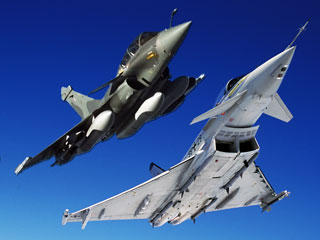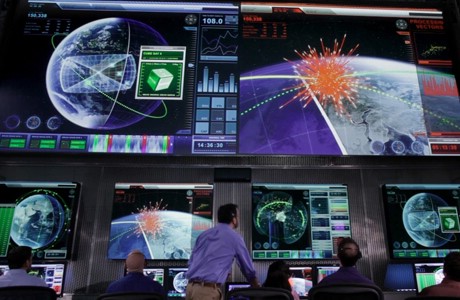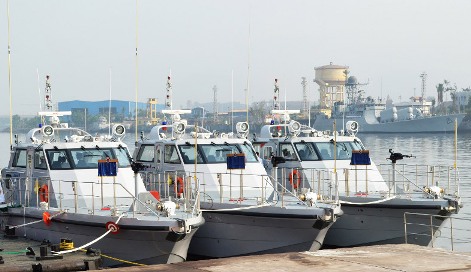
The Rafale & the Eurofighter Typhoon.
By Ritu Mousumi Tripathy
Early 2012. France was getting closer to clinch a mega military deal to sell its Rafale multi-role fighter jets to the Indian Air Force - a deal worth over US$11 billion at that point of time. If signed, it would have become the foremost and biggest export deal for the French-made four+ generation fighter.
Come 2015, and things have moved nowhere.
With time and a regime change in New Delhi, the multi-billion dollar defence deal has been stuck in a quagmire. The swiftly-shifting tectonic plates at the global strategic level also appear to have some bearing on the same.
India, which has been importing most of its high-technology military hardware from overseas since its independence, has become hell-bent to gain the maximum, both in terms of technology and price, out of such a high-profile mega-budget deal wherein a major chunk of its annual defence budget would be spent on acquiring 126 of the new fighters.
Moreover, with a major thrust on the Make-In-India programme, to gain rich technological dividends from the MMRCA deal in the longer run has become the primary driving factor for the current Government.
Once optimistic and euphoric that it would certainly clinch the multi-billion dollar contract to supply such a large number of fighters to the Indian Air Force after emerging as the lowest bidder in the deal piping Eurofighter Typhoon, Dassault Aviation, has been involved in an excruciatingly long negotiation process with the Indian Defence establishment since 2012.
Interestingly, while the French fighter had no takers worldwide when India shortlisted it for the MMRCA deal, today it has found a customer at last, with Egypt inking a contract this year to buy 24 of the Rafale fighters. Dassault, otherwise, has already lost a contract in Brazil and one in Switzerland to sell its Rafales.
Coming back to the Indian turf, a lot of factors appear to have been working against the French fighter to make its headway into the IAF's fleet. While negotiations with the state-run HAL is going on, the major hurdle, as per reports, involves cost of production.
The RFP issued by the Indian Defence Ministry for the MMRCA contract has stipulated that the winner of the contract will supply 18 of the 126 fighters to the IAF in flyaway condition, while the remaining 108 fighters would be licence-built at HAL's facilities in India.
Dassault, for its part, has refused to stand guarantee for all the 108 Rafales to be built in India and their production cost. The major issue of contention between the two sides is the original tender issued by the Indian Government way back in 2007, and Dassault's reported veering off from the same now.
The French firm has been arguing that the integration cost of Rafale would go up if assembled at India's HAL which does not have economies of scale. Furthermore, the productivity of labour in the Indian state-run firm is not very high compared to its French counterparts, it has said.
Meanwhile, ongoing events at the global stage, especially the Russia-West tussle over the Ukraine crisis and France's refusal to hand over the Mistral-class helicopter carriers to Moscow, the contract for which was signed in 2011, appear to have some bearing on the outcome of India's mega budget fighter deal.
Moscow, one of New Delhi's most trusted strategic allies supplying critical military technology and hardware since decades, has been persuading India not to go for the French fighters on the ground that it may face the same fate as the Mistral-class of warships France was contracted to deliver to Russia. On the other hand, it has been hard-selling few of its own fighters, including the Su-30MKI (already operational with the IAF) and the under-development Su-35 fighter as a replacement for the French Rafale.
Eurofighter Typhoon, which was drubbed by the French fighter, too has made several attempts to woo India to reconsider the deal in its favour.
Many military analysts have also suggested production and induction of more of India's own light combat aircraft Tejas into the IAF rather than buying the French fighters at a whopping cost, expected to exceed US$20 billion, if signed today. Few have also pitched in favour of Russia's fifth-generation fighter aircraft (FGFA) in which India is a partner. The Government, however, has delinked MMRCA from the FGFA deal.
While the IAF has since long felt the urgent need for a four+ generation warplane in its arsenal in the face of its depleting force level of 32 fighter squadrons as opposed to the required 42 fighter squadrons, it is at the political level that the issue has been hauled up, and a final decision at the highest level is still awaited.
The Indian Government, for its part, is walking a tight rope, signalling that it's not being swayed away by any of the parties pressurising it to take a call in their favour. After all, the ultimate result must address the immediate security issues of the IAF and the Nation at large.
Amidst so much twists and turns coming in the way of the MMRCA deal - once pegged as the "mother-of-all" deals - who then becomes the ultimate winner and who the loser?
Only time will reveal.
 Previous Article
Previous Article Next Article
Next Article












The Indian Air Force, in its flight trials evaluation report submitted before the Defence Ministry l..
view articleAn insight into the Medium Multi-Role Combat Aircraft competition...
view articleSky enthusiasts can now spot the International Space Station (ISS) commanded by Indian-American astr..
view article